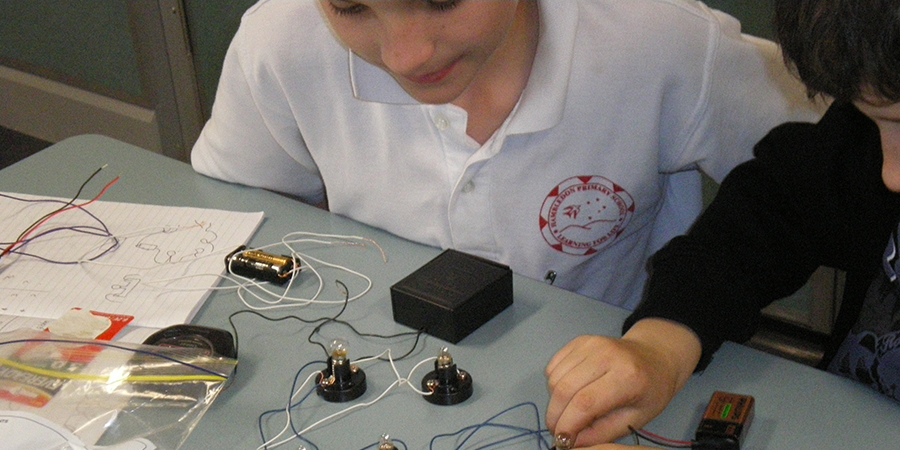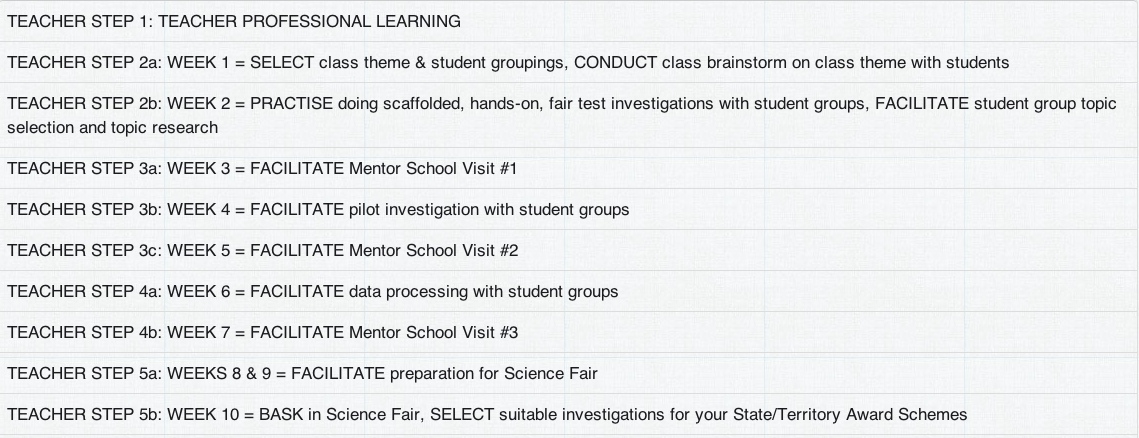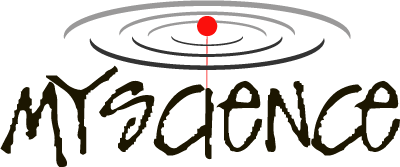TEACHER STEP 2
STEP 1
Professional Learning & Preparation
STEP 2
Phase 1 – High Direction
STEP 3
Phase 2 – Mentored Exploration
STEP 4
Phase 3 – Independence
STEP 5
Presentation & Celebration

Goals for STEP 2
- Select Mentor/MySTic DATES and TIMES (90 minutes/session) for the three school visits, and Science Fair, and communicate these to mentors and the school community
- Select a CLASS THEME for student investigations and communicate this to mentors
- Form STUDENT GROUPS in pairs or threes
- Provide each student with a LOG BOOK
- Explain the MYSCIENCE PROCESS to students
- Conduct a CLASS BRAINSTORM on your theme
- Conduct SCAFFOLDED, HANDS-ON scientific investigations WITH STUDENTS related to the class theme
- Facilitate TOPIC SELECTION and RESEARCH with student groups
- Test your KNOWLEDGE before moving on to STEP 3
Scroll down for more information.
STEP 2 – Plan Ahead
- DATES & TIMES: select & communicate to Mentors/MySTics for school visits & Science Fair
- THEME: select & communicate to Mentors/MySTics
- STUDENT GROUPS: select
- LOGBOOKS: for each student
- MYSCIENCE PROCESS: explain to students
- BRAINSTORM: theme with class
- PRACTICE: investigations related to theme
- TOPICS: selection by groups from brainstorm
- TOPICS: research by groups
- FOCUS/TESTABLE QUESTION: students begin** to narrow down
** NOTE: Selection of each group’s final question occurs during Mentor Visit #1 in STEP 3
STEP 2 covers WEEKS 1 & 2 of Implementation

STEP 2 – Information
Steps in Planning MyScience Investigations
WATCH the PPT presentation via Resource Button 2.1 for information about ‘Planning MyScience Investigations’.
The STEPS include:
- Choosing a THEME
- Brainstorming TOPICS within the theme
- Generating TESTABLE questions for investigation
- Working with Mentors/MySTics to identify one FOCUS QUESTION
- Equipment and Chemical SAFETY
Themes
The class THEME is used to conduct a class BRAINSTORM from which a number of TOPICS arise. Each student group selects a TOPIC AREA and then generates TESTABLE QUESTIONS.
- ‘2.1 Planning MyScience Investigations’ has THEME information on SLIDES 1-4.
- ‘2.2 Theme Ideas’ presents a list of TEACHING THEMES that are broad enough to accommodate a wide range of student interest areas and to address most school teaching programs. Successful themes that have been used in MyScience include: Change, Communication, Energy, Environment, Global Issues, the Human Body, Transport, Mythbusters and Weather.
- ‘2.3 Mythbuster Theme’ presents benefits for having a theme.
- ‘2.4 Themes > Topics > Questions’ has some examples of Themes, Topics and Questions that would be suitable to use as a foundation for Stage 3 (Years 5-6) students.
Student groups
- Students learn more, think more deeply and are more engaged when they work in groups.
- Justifying ideas to others requires evidence – not just an opinion.
- Student groupings can be formed by teacher selection (ability, age, gender), student selection (often based on friendship) or a mixture of both considering, for instance, areas of interest.
- Use the following Resource Buttons for information:
- ‘2.5 Tips on Using Role Badges’
- ‘2.6 Tips on Working in a Team’
Logbooks
- Students use their logbook to record their thoughts, ideas, results of their scaffolded investigations and their MyScience investigation progress – particularly any ideas provided by mentors.
- Submission of a Logbook as well as a Report is required by many Award Schemes.
- ‘2.7 Logbook Example’ demonstrates what Year 6 students may produce.
MyScience Process (for students to know about)
- Students need to know where the next few weeks are heading and they particularly need to aware of their ROLES and RESPONSIBILITIES, which are detailed in Teacher Step 1: Resource ‘1.1 Participants’ Roles & Responsibilities’.
- A STUDENT WEEKLY SEQUENCE at Resource Button ‘2.8 Student Weekly Sequence’ lets students know that there will be MENTORS/MySTics coming to school to work with them, and that they need to ultimately present their findings to others at a SCIENCE FAIR.
Brainstorm
The class theme is the basis for the class BRAINSTORM from which a number of TOPICS arise.
For BRAINSTORM information go to:
- ‘2.1 Planning MyScience Investigations’ SLIDES 5-10
- ‘2.9 Brainstorming a Theme’
- TAKE A PHOTO of the completed brainstorm, which needs to be retrieved for STEP 5. Even better – print a copy for each student’s logbook.
Topics
TOPICS arise from the class Brainstorm. Each student group selects ONE TOPIC AREA and then generates TESTABLE QUESTIONS.
- ‘2.10 Topic Research Issues’ presents students describing their experiences of using the internet to research their topic.
- Revisit ‘2.4 Themes > Topics > Questions’ for some STAGE 3 EXAMPLES of links between Themes, Topics and Questions.
Testable Questions
TESTABLE QUESTIONS, based on each group’s selected Topic, are quite ‘tricky’ for students to generate.
For now you only need to assist students to narrow down some focus questions because the FIRST SCHOOL VISIT is where each group’s ‘Testable Question’ is finalised through interactions with the Mentors/MySTics.
As the teacher, you need to know about Testable Questions. Use the links below to expand your knowledge and understanding:
- ‘2.1 Planning MyScience Investigations’ SLIDES 11-18 = TESTABLE QUESTION information.
- ‘2.4 Themes > Topics > Questions’ = EXAMPLES of STAGE 3 Questions derived from Topics and Themes.
- ‘2.11 Testable Questions’ = CRITERIA within MyScience
- ‘2.12 Mythbuster Testable Question’ = How students chose their question.
